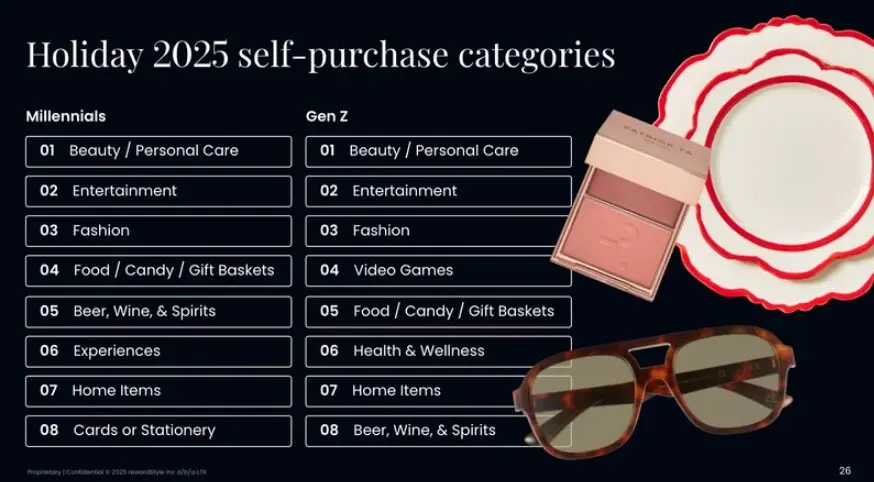- Creators as core purchase drivers: 70% of consumers act on creator recommendations, with trust levels rising 21% year-over-year.
- Self-gifting goes mainstream: 90% of shoppers will buy for themselves this season, shifting retail narratives beyond traditional gift-giving.
- Availability > price: Anticipated shortages are pushing 43% of shoppers to start as early as September, guided by creator suggestions.
- Full-funnel influence: From discovery to conversion, creator content now drives trust, validation, and in-store engagement.
- Personalization and platform expansion: Audiences want creator-led influence across streaming, CTV, and micro-communities that reflect their identities.
From discovery to conversion, creator content is influencing in-store browsing, online sales, and brand trust - new LTK study finds.
The LTK Holiday Shopper Study underscores a pivotal shift: creators have cemented themselves as the most trusted guides in the retail economy. Among Gen Z and Millennials, creators rank as the number one source shaping holiday purchases, while 70% of the general population now acts on creator-driven recommendations.
This represents a 21% year-over-year surge in trust, a metric that reinforces how creator content has evolved beyond simple influence into a form of social proof that rivals traditional advertising. For marketers, this signals a demand for partnerships that emphasize authenticity, relatability, and long-term audience alignment.
Self-Gifting Reframes the Holiday Narrative
Another standout trend is the mainstreaming of self-gifting. This year, 90% of consumers report planning to shop for themselves while buying gifts for others. What was once a secondary behavior has become central to holiday retail strategy, with beauty, personal care, entertainment, and fashion emerging as dominant categories.
The practice reflects a broader cultural shift: consumers are no longer seeing the holidays strictly as an outward-facing ritual but as a moment to invest in their own well-being and identity. For brands, this expands campaign opportunities beyond traditional gift-giving and into a dual narrative—positioning products as both outward gifts and inward indulgences.
Early Shopping Driven by Scarcity and Creator Guidance
The study also reveals that product availability has surpassed price as the leading factor influencing purchase decisions. More than half of shoppers (53%) expect inventory shortages this season, and 61% say they rely on creators to recommend in-stock alternatives. This urgency is pulling shopping timelines forward, with 43% of consumers planning to start holiday purchasing by September—an increase of 13% from last year.
The implication for brands is clear: creator campaigns must be activated earlier in the calendar, with messaging that emphasizes availability, reliability, and readiness to meet demand before peak-season competition intensifies.
Creators Across the Entire Funnel
The most striking finding from the LTK study is the extent to which creators now influence every stage of the purchase funnel. No longer confined to awareness, creator content is now integral to consideration, conversion, and even post-purchase trust-building.
Three in four consumers report wanting to see creator content while actively shopping—whether in-store or on a brand’s own website. Furthermore, 84% of shoppers say they trust brands more when creators review products on brand-owned platforms. This positions creators as not only discovery engines but also as validation tools within retail environments, blurring the line between paid media, earned trust, and owned commerce experiences.
Expanding Beyond Social Into Streaming and CTV
The study highlights a new frontier for creator commerce: migration beyond social platforms. Shoppers increasingly want creator-driven content across streaming services and connected TV, reflecting the diversification of consumer attention.
This broadens the creator playbook, moving influence into spaces traditionally reserved for entertainment and mass advertising. For marketers, this means rethinking media planning—allocating spend to creator-led integrations across channels where audiences are deeply engaged but less resistant to branded messaging.
Personalization as the Next Competitive Edge
Finally, personalization is emerging as the defining driver of creator influence. Sixty-seven percent of LTK users say they return to the same creators repeatedly, seeking alignment on style, values, lifestyle, and even location.
This indicates a shift from broad influencer reach to micro-communities of resonance, where repeated engagement is a key driver of conversion. Brands that cultivate relationships with creators who closely mirror their target audience’s identity stand to gain not only higher trust but also more durable customer relationships built on shared affinities.
A Redefined Holiday Economy
The 2025 holiday season is set to demonstrate how creator-led commerce has matured into a structural pillar of retail strategy. Trust levels are at all-time highs, shopping timelines are accelerating, and creator content now spans the entire purchase funnel—from discovery and validation to conversion and loyalty.
For brands, the lesson is not simply to include creators in seasonal campaigns, but to reframe creators as essential partners in shaping consumer behavior across every touchpoint. The study confirms what has become increasingly evident: creator influence is no longer additive—it is foundational to modern retail.




